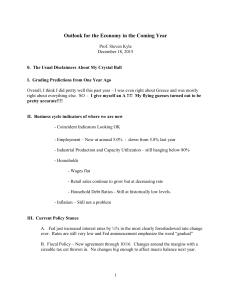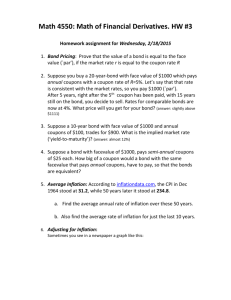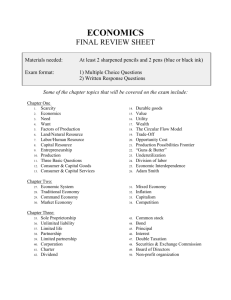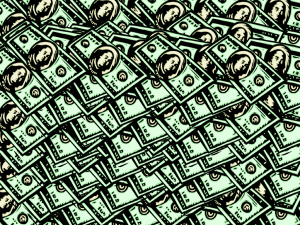1. True or false? Briefly explain. (a)
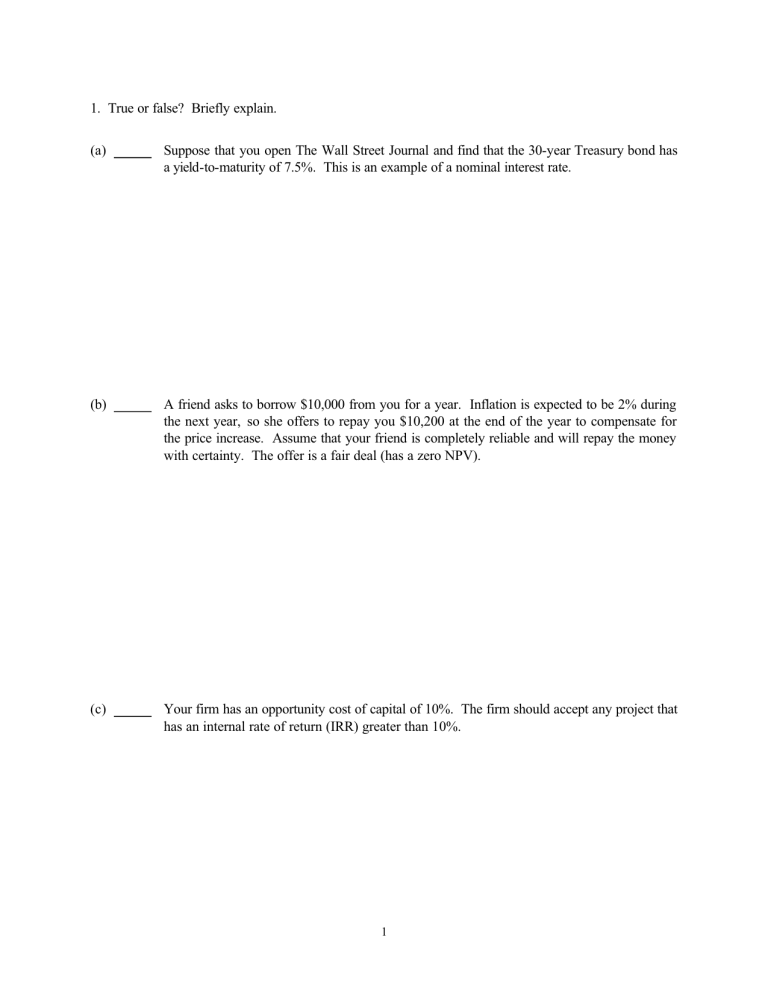
1. True or false? Briefly explain.
(a) Suppose that you open The Wall Street Journal and find that the 30-year Treasury bond has a yield-to-maturity of 7.5%. This is an example of a nominal interest rate.
(b) A friend asks to borrow $10,000 from you for a year. Inflation is expected to be 2% during the next year, so she offers to repay you $10,200 at the end of the year to compensate for the price increase. Assume that your friend is completely reliable and will repay the money with certainty. The offer is a fair deal (has a zero NPV).
(c) Your firm has an opportunity cost of capital of 10%. The firm should accept any project that has an internal rate of return (IRR) greater than 10%.
1
1. True or false, cont.
(d) Your firm needs to raise $300,000 and has decided to sell corporate bonds. An investment bank advises that you can sell 3-year bonds with a yield-to-maturity of 7% or 8-year bonds with a yield-to-maturity of 8.5%. From the firm’s perspective, the short-term debt is cheaper because it has a lower yield-to-maturity.
(e) You expect to earn $50,000 this year and would like to spend $45,000 on current consumption (you plan to save the remaining $5,000). Unexpectedly, you get an opportunity to invest $10,000 in a project that will repay $13,000 in one year. If the current interest rate is 10%, you should take this investment even though you had planned to save only $5,000.
(f) If the U.S. government will pay the coupon and principal on Treasury bonds with certainty, then Treasury bonds are a riskfree investment.
2
2.
The Federal Reserve (the Fed) is responsible for maintaining low inflation in the U.S. To keep inflation low, the Fed attempts to control short-term interest rates. In this problem, we are going to analyze how the Fed affects the term structure of interest rates.
(a) Suppose the inflation rate for the coming year is expected to be 3%. Investors expect inflation to rise to 4% in the second year and 5% in the third year. If the expectations hypothesis is true, what is the general shape
of the term structure of interest rates? Why?
(b) Assume that the real rate of interest is 1%. In other words, the one-year spot rate is always expected to be 1% greater than the inflation rate. If the expectations hypothesis is true, what are the one-year forward rates for years 2 and 3? Explain. For this problem, you may use the approximate formula relating the real rate to the nominal rate.
3
(c) Continuing from part (b), what are the current 2- and 3-year spot rates (r
2
and r
3
)?
(d) The Fed wants to reduce future inflation (it cannot do anything about inflation in the coming year). To do this, the Fed raises the real
rate of interest to 2%. Assume that the Fed is successful, and expected inflation rates for years 2 and 3 both drop to 3%. If the expectations hypothesis is true, what affect does the Fed have on the term structure of interest rates? Be specific: what are the new spot and forward rates?
4
3.
A two-year, 8% coupon bond with a face value of $1,000 has a current price of $1,000. Assume that the bond makes annual coupon payments. The term structure of interest rates is flat.
(a) What is the bond’s yield-to-maturity?
(b) Using the concept of duration, find the approximate percentage change in the price of the bond if the yield-to-maturity drops by 1%.
(c) Compared with the coupon bond in this problem, would the price of a two-year, U.S. Treasury STRIP change more or less in response to the change in interest rates? Why?
5
4.
Genzyme is a local biotechnology firm that invests heavily in research and development.
(a) Currently, Genzyme re-invests all of its cashflows to help fund new R&D. Investors expect Genzyme to produce zero net cashflows for the next 5 years. In the 6th year, Genzyme is expected to have cashflows of $100 million, which is then expected to grow at a constant rate of 8% forever. If investors require a 13% rate of return, what is the current value of Genzyme? (Assume all cashflows occur at the end of the year.)
(b) Genzyme announces that it has just discovered a new drug, Heartgo, to treat heart disease. The firm has already spent $40 million developing Heartgo, and will have to spend an additional $10 million immediately to prepare the drug for sale. Heartgo is expected to generate cashflows of $30 million for
10 years, with the first cashflow received in one year. What is the new market value of Genzyme after the announcement?
6
5.
You work for a small pottery company that is considering selling products on the Internet. After careful analysis, you estimate that the firm would need to spend $80,000 developing a Web site and integrating it with the firm’s inventory system. For tax purposes, this investment can be depreciated using straight-line depreciation over 4 years (the salvage value is zero). The Web site will generate an additional $100,000 in sales. The costs of good sold will equal $60,000. To support these sales, inventory will have to increase by $8,000 in the first year. Inventory will remain at this level until the end of the project in 4 years, at which time it will drop back to its original level. The tax rate is 40% and the cost of capital is 10%.
Should the firm proceed with this project?
7
Formula sheet
NPV = CF
0
+
CF
(1
+
1 r)
+
(1
CF
+
2 r)
2
+
CF
3
(1
+ r)
3
+
CF
4
(1
+ r)
4
+ L
PV of an annuity = C
⎡
1
⎣ r r(1
1
⎤
+ r)
T ⎦
⎥
PV of a perpetuity =
C r
PV of a growing perpetuity =
C
1 + real rate of interest = (1 + nominal rate) / (1 + inflation rate) real rate of interest
≈
nominal rate – inflation rate real CF t
= no min al CF t
(1
+ inflation rate) t
EAR =
[
1
+
APR / k
] k −
1
Bond price (general) =
(1
C
+
)
+ +
2
)
C
+
3
) 3
+ r (1
C
+
C r (1
+
FV
) T
Bond price (semiannual coupons) = Coupon
⎡
1
⎣ r/2
1 r/2 (1
+ r/2) 2T ⎦
⎤
⎥ +
FV
(1
+ r/2) 2T
Spot rate: (1 + r t
) t
= (1 + r
1
)
×
(1 + f
2
)
×
(1 + f
3
)
×
…
×
(1 + f t
)
Forward rate: 1 + f t
=
( 1
+ r ) t
(1
+ r t 1
) t − 1
Duration =
PV(CF
1
)
⋅
1
+
PV(CF
2
)
⋅
2
+
PV(CF
3
)
⋅
3
+
...
+
PV(CF
T
)
⋅
T
Price Price Price Price
% change in price
≈
– Duration
× change in
1
+ r r
9



